Comprehensive RFP Checklist for Winning Proposals
Learn how to create an effective RFP checklist to streamline your proposal process, enhance collaboration, and ensure timely, accurate submissions for better outcomes.
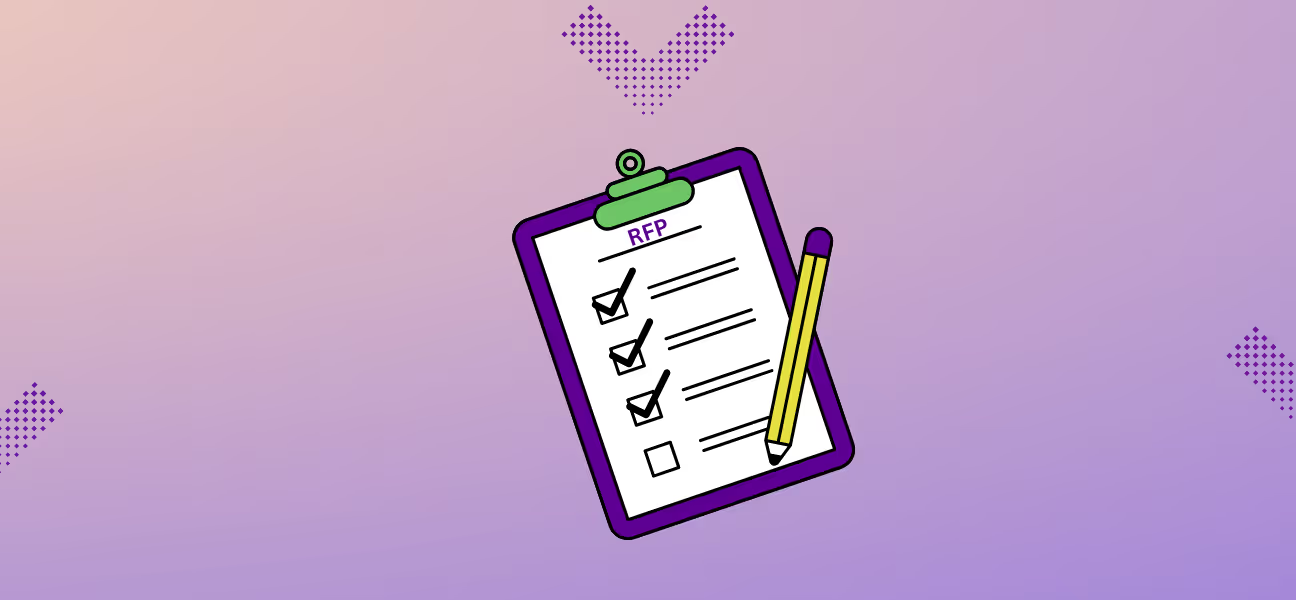
The RFP (Request for Proposal) process can be a major bottleneck for businesses, leading to delays, inefficiencies, and missed opportunities. A report by OpenAsset reveals that 20% of RFPs go unfinished annually, costing companies an average of $725,000.
Proposal managers and sales teams often face the challenge of managing complex workflows while ensuring accuracy, compliance, and client-specific customization. These hurdles can slow the process and lead to inconsistent responses, ultimately impacting win rates.
This is where a well-structured RFP checklist becomes invaluable. It helps avoid mistakes, covering every step from start to finish. Think of it as a roadmap that keeps things on track, minimizes errors, and ensures deadlines are met without sacrificing quality.
In this blog, we’ll cover the key elements of an effective RFP checklist, the importance of customization and workflow optimization, and how automation boosts efficiency and accuracy, ultimately helping your team win more business.
Key Takeaways
- RFP checklist helps streamline proposal processes, reducing errors and ensuring timely submissions.
- Understanding the RFP process helps optimize responses and increase your chances of winning.
- Key components of an effective checklist: clear objectives, defined roles, timelines, collaboration, and quality control.
- Customization is key to aligning the checklist to meet the specific needs of your industry for better outcomes.
- AI-powered tools can automate content population, streamline review, and optimize workflows, improving efficiency.
What is an RFP Checklist and Why is it Essential?
An RFP checklist is more than just a to-do list; it’s a blueprint that ensures every step in the proposal process is executed correctly, reducing errors and delays. Without it, teams risk missing crucial details, leading to missed opportunities. Proposal managers and sales teams often face the challenge of managing extensive documents and tight deadlines, which can slow the process down.
A well-organized checklist breaks the process into manageable steps, ensuring key elements like compliance, pricing, and customization are covered. It keeps teams aligned, minimizes confusion, and guarantees timely submissions without compromising quality.
For businesses using AI-powered automation, a checklist adds even more value. It combines automation with human oversight, improving speed, accuracy, and efficiency.
Now that we’ve covered the checklist, let’s look at the RFP process to see how it all unfolds and where your checklist fits in.
How Does the RFP Process Look?

Understanding the RFP process helps streamline responses and ensures your proposals are targeted. Here’s how the process typically works:
1. RFP Creation by the Buyer
- The buyer identifies their needs and drafts an RFP, outlining the project scope, objectives, timeline, budget, and evaluation criteria.
- The RFP is internally approved before being sent to potential vendors.
2. RFP Distribution to Vendors
- The buyer issues the RFP to vendors, either publicly or privately.
- Vendors may submit clarification questions, which are answered by the buyer.
3. Vendor Response and Proposal Submission
- Vendors prepare and submit their proposals, often using an RFP checklist to ensure they meet all requirements.
- Internal teams collaborate to create a well-aligned, comprehensive response.
4. Evaluation of Responses
- The buyer reviews and scores proposals based on predefined criteria such as cost, technical fit, and compliance.
- A shortlist of vendors is created for further consideration.
5. Vendor Presentations or Interviews
- Shortlisted vendors may be invited for presentations or interviews to clarify details or answer questions.
- Negotiations follow, focusing on pricing, scope, and contract terms.
6. Contract Award and Final Decision
- The buyer selects the winning vendor and awards the contract after final negotiations.
- The contract is signed, and the project officially begins.
Now, let’s break down the key components that will make your RFP responses more efficient and effective.
Key Components of an Effective RFP Checklist

An effective RFP checklist ensures smooth, organized proposal responses. It helps teams stay focused on key tasks and avoids unnecessary delays. Here are the essential components of any RFP checklist:
- Clear Objective Setting: Understand the client’s needs, goals, and priorities. Align your team’s efforts around these insights to ensure the response directly addresses their requirements, saving time and effort on irrelevant details.
- Roles and Responsibilities: Assign clear ownership for each task—content creation, compliance checks, and reviews. This prevents overlap, reduces bottlenecks, and ensures timely, high-quality completion.
- Timeline and Milestones: Set realistic deadlines for each stage of the process, from drafting to submission. A clear timeline helps manage expectations and prevents delays that could impact your success.
- Collaboration and Communication Plan: Centralize communication to ensure everyone knows how to share feedback, provide updates, and when approvals are due. This keeps teams aligned and prevents errors or missed opportunities.
- Quality Control and Final Review: Implement a structured review process, including proofreading and compliance checks, ensuring that the proposal meets client requirements and is error-free before submission.
With the right components in place, let’s dive into a practical, step-by-step guide for creating your own RFP response checklist for accuracy and efficiency.
How to Create an RFP Response Checklist: A Step-by-Step Guide
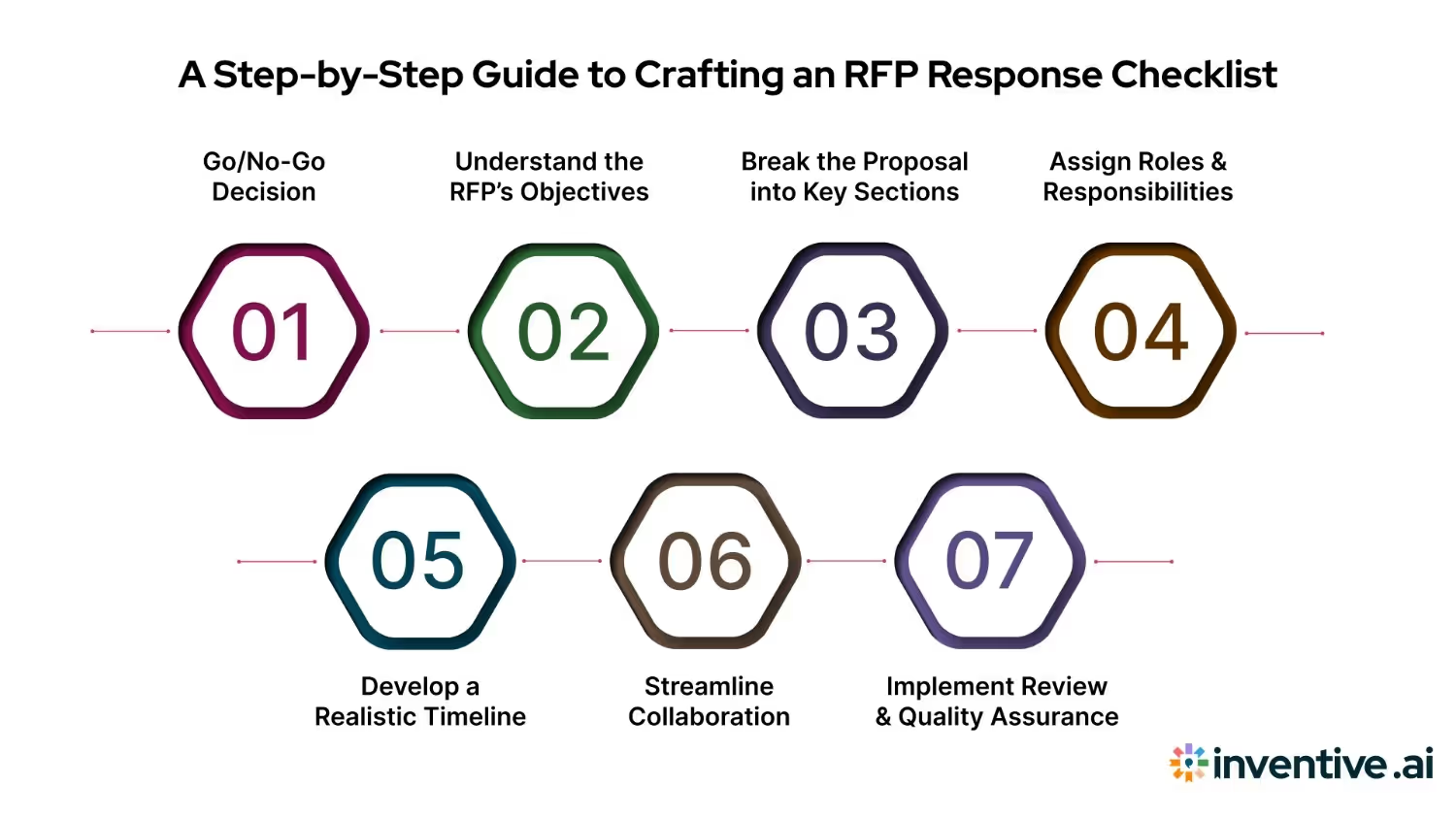
Creating an RFP response checklist isn’t just about listing tasks, it’s about optimizing the entire process to ensure accuracy, efficiency, and timeliness. Here’s a step-by-step guide on how to create a checklist:
Step 1. Go/No-Go Decision
Before diving into the RFP response process, it’s essential to make a Go/No-Go decision. This is a critical checkpoint where you evaluate whether your company should move forward with the proposal based on factors such as:
- Alignment with your capabilities and expertise.
- The strategic value and potential return on investment (ROI) from the project.
- The fit with your company’s goals and objectives.
- If the proposal meets your capacity, timeline, and resource requirements.
This decision helps ensure that you don’t waste valuable resources on RFPs that may not be the right fit.
Step 2. Understand the RFP’s Objectives and Requirements
Before diving into any proposal work, it’s essential to have a solid understanding of the client’s pain points, project scope, and key objectives. By clearly identifying what the client values most, you can tailor the proposal to directly address their needs and avoid wasting time on irrelevant details.
- Read the RFP carefully: Go beyond skimming and understand the client's pain points, desired outcomes, and the problem they need solving.
- Dissect the key requirements: Highlight critical sections in the RFP, such as deliverables, compliance requirements, pricing terms, and evaluation criteria.
- Align your response strategy: Tailor your approach to directly address the client’s goals, ensuring that your solution aligns with their needs.
- Clarify questions with the client: If there’s any ambiguity, reach out to the client for clarification to ensure a crystal-clear understanding of the RFP.
- Prioritize elements that matter most: Focus on the critical requirements that will impact the evaluation, such as budget constraints or mandatory deliverables.
Example: For a government contract requiring strict compliance, focus on delivering a solution that meets all legal and regulatory standards. Similarly, for a tech startup, emphasize scalability and innovation in your proposal.
Step 3. Break the Proposal into Key Sections
Once the RFP is fully understood, break the proposal into sections that are easier to manage and assign. This helps to organize the workflow and ensures that all components are covered thoroughly. Each section should be specific to a task or responsibility.
- Executive Summary: Draft a concise pitch that addresses the client’s needs and showcases your solution’s value.
- Scope of Work: Define deliverables, timelines, and responsibilities clearly. Ensure there's mutual understanding of what’s included and excluded.
- Technical Approach: Describe how the project will be executed, including tools, processes, and methodologies that support your solution.
- Pricing Model: Provide a detailed, transparent breakdown of costs, payment schedules, and value offered.
- Compliance & Legal Terms: Ensure all legal requirements, such as NDAs or certifications, are included to guarantee full compliance.
Example: If a manufacturing proposal requires ISO certifications, be explicit about your compliance. Similarly, in a software solution proposal, show a roadmap with clear milestones for each deliverable.
Step 4. Assign Roles and Responsibilities
Define ownership for every section of the proposal. This ensures no task is overlooked and streamlines the process by making each team member responsible for specific components. Clear ownership helps reduce confusion and speeds up response time.
- Team Ownership: Assign clear ownership of each section of the proposal. Ensure that those responsible for the Executive Summary, Pricing, Technical Approach, and Legal Terms have the right expertise.
- Set deadlines for each phase: Schedule time for drafts, reviews, internal feedback, and final submissions. Each task should have a designated owner.
- Ensure accountability: Make sure the responsible team members are aware of their roles, expectations, and timelines. Use project management tools to track progress.
Example: The sales team may be best suited to work on the Executive Summary, while the legal team handles the Compliance & Legal Terms.
Step 5. Develop a Realistic Timeline
Creating a timeline is key for ensuring the proposal process stays on track and is completed on time. You need to allocate sufficient time for each phase, while also accounting for potential delays or issues that may arise.
- Initial Draft: Allocate time for the creation of the first draft. Ensure there's enough time for internal reviews and revisions.
- Internal Reviews: Set deadlines for reviews and feedback rounds from each department involved (e.g., sales, compliance, legal, technical).
- Final Approval and Submission: Give extra time for final approvals to avoid last-minute rushes.
- Buffer Time: Include buffer time to accommodate unforeseen issues, such as feedback delays or required last-minute changes.
Example: A 5-day review period may be needed for technical accuracy, followed by a 2-day compliance check to ensure all regulatory standards are met.
Step 6. Streamline Collaboration and Communication
Effective collaboration is critical when multiple teams are involved. Establishing a centralized communication plan ensures that all team members stay aligned and that feedback is easily shared throughout the process.
- Centralized Document Management: Use tools like Google Docs, Slack, or SharePoint to store and share documents in real-time.
- Define Collaboration Platforms: Decide where comments will be tracked, such as in project management tools like Trello or Asana.
- Set Communication Protocols: Define how feedback will be communicated (e.g., through weekly meetings or shared review documents).
- Team Check-ins: Schedule regular check-ins with team members to keep the proposal moving forward and align all teams.
Example: Use Slack channels for real-time feedback and Google Docs for collaborative editing. This allows the sales and technical teams to work together efficiently without overlap.
Step 7. Implement Review and Quality Assurance
Before finalizing the proposal, it’s crucial to implement a review process that checks for compliance, consistency, and quality. Each section should go through a structured review, ensuring the proposal meets both internal and external standards.
- Proofreading: Assign someone to check for grammar, spelling, and formatting consistency.
- Compliance Review: Ensure the proposal complies with client specifications and regulatory requirements.
- Content Consistency: Have team members review the document for alignment across sections (e.g., making sure the pricing in the Scope of Work matches that in the Pricing Model).
- Final Read-through: Conduct a final review of the proposal to ensure all sections are cohesive and meet the client’s needs.
Example: In a healthcare RFP, your compliance team must ensure all HIPAA requirements are met. If the proposal includes technical jargon, a second reviewer from a non-technical department should ensure it’s clear for a broader audience.
Step 8. Continuously Improve the Checklist
Once the proposal is submitted, take time to review the process and assess where improvements can be made. Identifying pain points or bottlenecks helps refine your checklist for future responses, making them more efficient.
- Post-Submission Review: After submitting each proposal, conduct a thorough analysis of the process.
- Identify Bottlenecks: Look for stages where the proposal process slowed down or where tasks were delayed.
- Update Templates and Checklists: Use feedback from previous RFPs to update templates and processes, making future submissions more efficient.
- Incorporate Client Feedback: If you receive feedback from clients on why proposals were rejected or selected, incorporate those insights into your checklist and templates.
Example: If you find that the pricing review took longer than expected in past proposals, you could build more time into that phase in future checklists or automate parts of it using software.
Not all checklists work for every industry! Let’s move on to the next step to see how a customized checklist can be created.
How to Build a Customized RFP Checklist for Your Business
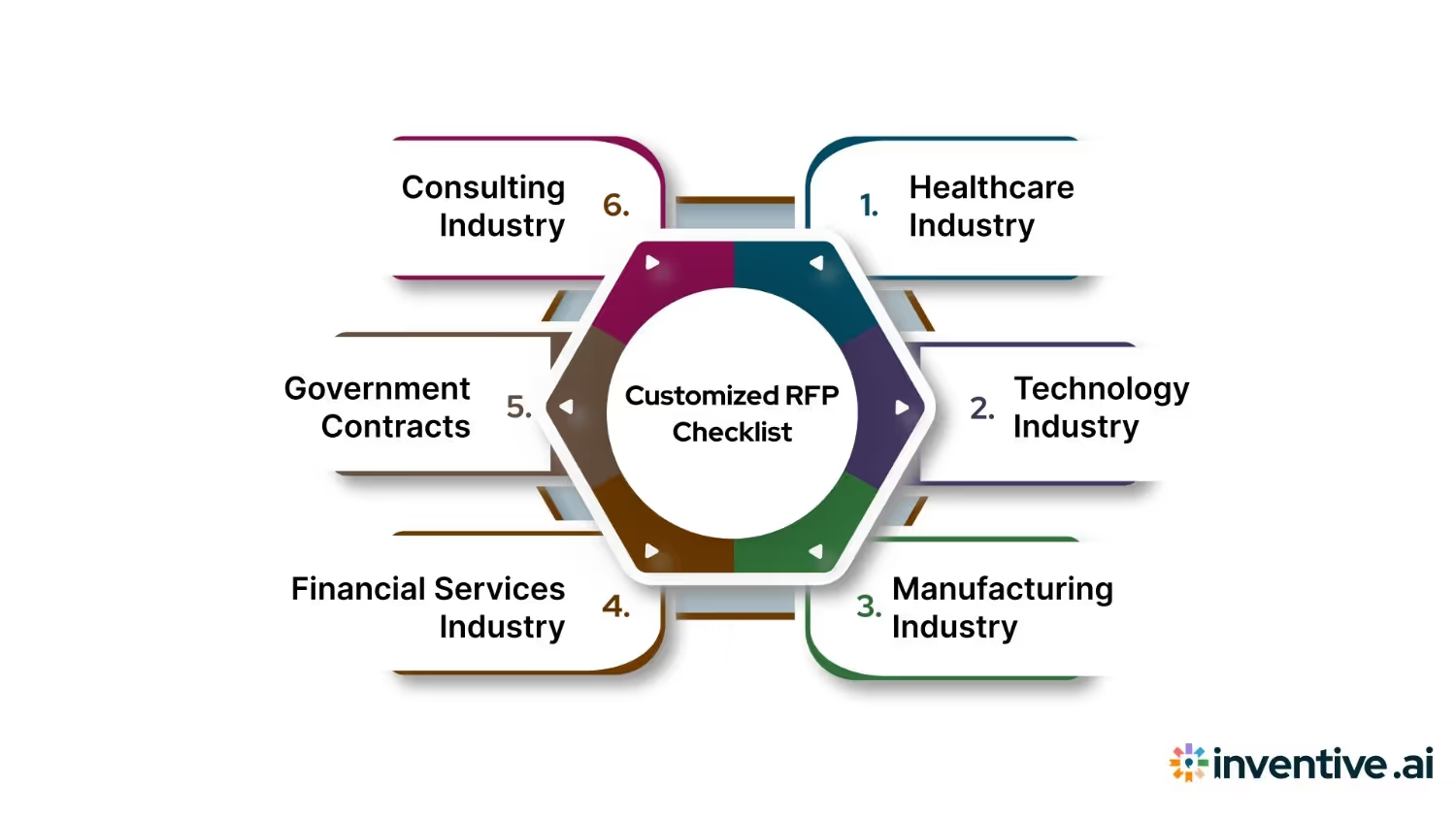
A generic RFP checklist won’t cut it. To stand out and win more deals, your checklist must be tailored to your business’s unique needs and industry challenges. Below, we break down how you can create customized RFP checklists for various industries.
1. Healthcare Industry RFP Checklist
Healthcare RFPs often require stringent compliance with regulations such as HIPAA, detailed technical specifications, and specialized knowledge of healthcare systems.
It’s crucial to include compliance checks, a clear understanding of healthcare laws, and a well-defined implementation plan to meet patient care standards.
2. Technology Industry RFP Checklist
RFPs in the technology sector typically demand a focus on scalability, innovation, and the ability to meet specific software or hardware requirements. Technology companies must demonstrate a deep understanding of emerging trends, like cloud computing, machine learning, and AI.
Your checklist should prioritize clear technical explanations and innovation-driven solutions.
3. Manufacturing Industry RFP Checklist
For the manufacturing sector, RFPs typically focus on production timelines, cost efficiency, and quality assurance. A proposal should outline your ability to meet production standards, adhere to safety protocols, and manage logistics efficiently.
Your checklist should cover these details and ensure you’re competitive in terms of cost and production capacity.
4. Financial Services Industry RFP Checklist
The financial services industry often requires proposals that are highly focused on risk management, compliance, and financial stability. RFPs in this sector need to address how your solution aligns with industry regulations like SOX or FINRA.
Your checklist should ensure all financial regulations are met and that your proposal demonstrates your capability to protect sensitive financial data.
5. Government Contracts RFP Checklist
Government RFPs often have strict guidelines and compliance requirements, along with detailed expectations for budget transparency, security, and documentation.
Your checklist should make sure your response meets the government's specific needs while complying with both national and local regulations.
6. Consulting Industry RFP Checklist
Consulting RFPs focus on your ability to deliver actionable insights, strategic recommendations, and measurable results.
The checklist should ensure that your proposal clearly demonstrates how your consulting services align with the client’s business strategy and how you will deliver value over the long term.
Let’s dive into the common pitfalls to watch for, so you can avoid them and keep your proposals on track.
Post-Submission Checklist
After submitting the proposal, it’s crucial to stay proactive and manage the next steps efficiently. Here's a detailed Post-Submission Checklist to guide you through the post-submission phase:
- Track Submission Status: Confirm with the client that they’ve received your proposal and understand the timeline for their evaluation. Track any updates or requests for further information to keep your team prepared for the next steps.
- Follow-Up Strategy: Plan a follow-up after the client’s expected review period. Use this opportunity to address any questions, clarify details, and reinforce how your proposal meets their goals. Personalize your message to stay relevant.
- Prepare for Negotiations: Review your proposal with the team to identify flexible areas, like pricing or timelines. Be ready to respond quickly if the client requests changes or further information, while staying within your company’s boundaries.
- Evaluate Proposal Outcome: Whether accepted or rejected, analyze the outcome. Request client feedback to understand the reasons behind their decision and identify areas for improvement. Use this insight to refine future proposals.
- Continual Improvement: Apply lessons learned from each proposal to enhance your process. Review feedback, timing, and team coordination to improve the efficiency and effectiveness of future submissions.
Even though you follow the checklist, there are chances of common mistakes happening. Let’s understand those challenges and the solutions to avoid them.
Common RFP Response Process Pitfalls to Avoid
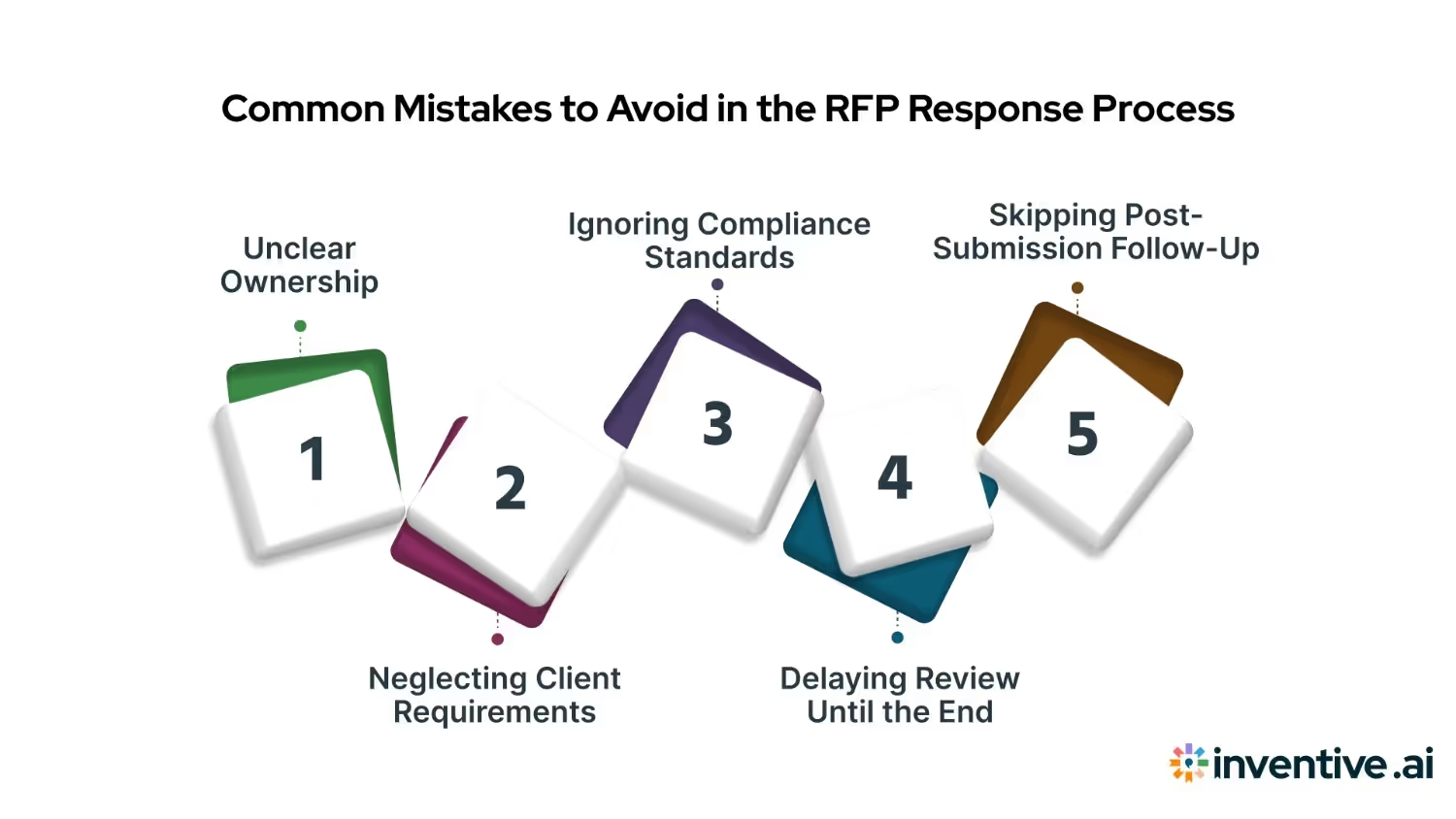
The RFP process can be riddled with pitfalls that, if overlooked, lead to delays, errors, and missed opportunities. By staying aware of these common mistakes and addressing them proactively, you can significantly improve your response quality. Here are key pitfalls to watch for:
- Lack of Clear Ownership: Without clear ownership, sections can be duplicated, missed, or poorly executed. Ensure each part of the proposal, from the Executive Summary to the final review, has an assigned owner, so every team member understands their responsibilities and deadlines.
- Overlooking Client Requirements: Focusing too much on your solution without addressing the client’s specific needs can make your proposal fall flat. Ensure every section speaks directly to the client’s pain points and shows how your solution meets their criteria.
- Ignoring Compliance Standards: Neglecting compliance can lead to disqualification. Whether it’s data security, legal agreements, or industry-specific regulations, make sure your proposal checks all compliance boxes, ensuring all mandatory requirements are met.
- Waiting Until the Last Minute to Review: Rushing the review process results in errors and inconsistent content. Set aside ample time for multiple review stages by key stakeholders (sales, legal, technical) to ensure the final proposal is polished and aligned with client needs.
- Lack of Post-Submission Follow-Up: Don’t submit and forget. Follow up with the client after submission to answer any questions, provide clarifications, or offer additional information. It shows initiative and keeps the proposal top of mind, increasing your chances of success.
To further enhance your RFP process, let’s explore how AI agents can help streamline the response and evaluation stages, ensuring efficiency and quality.
How AI Agents Help with RFP Response Process and Evaluation
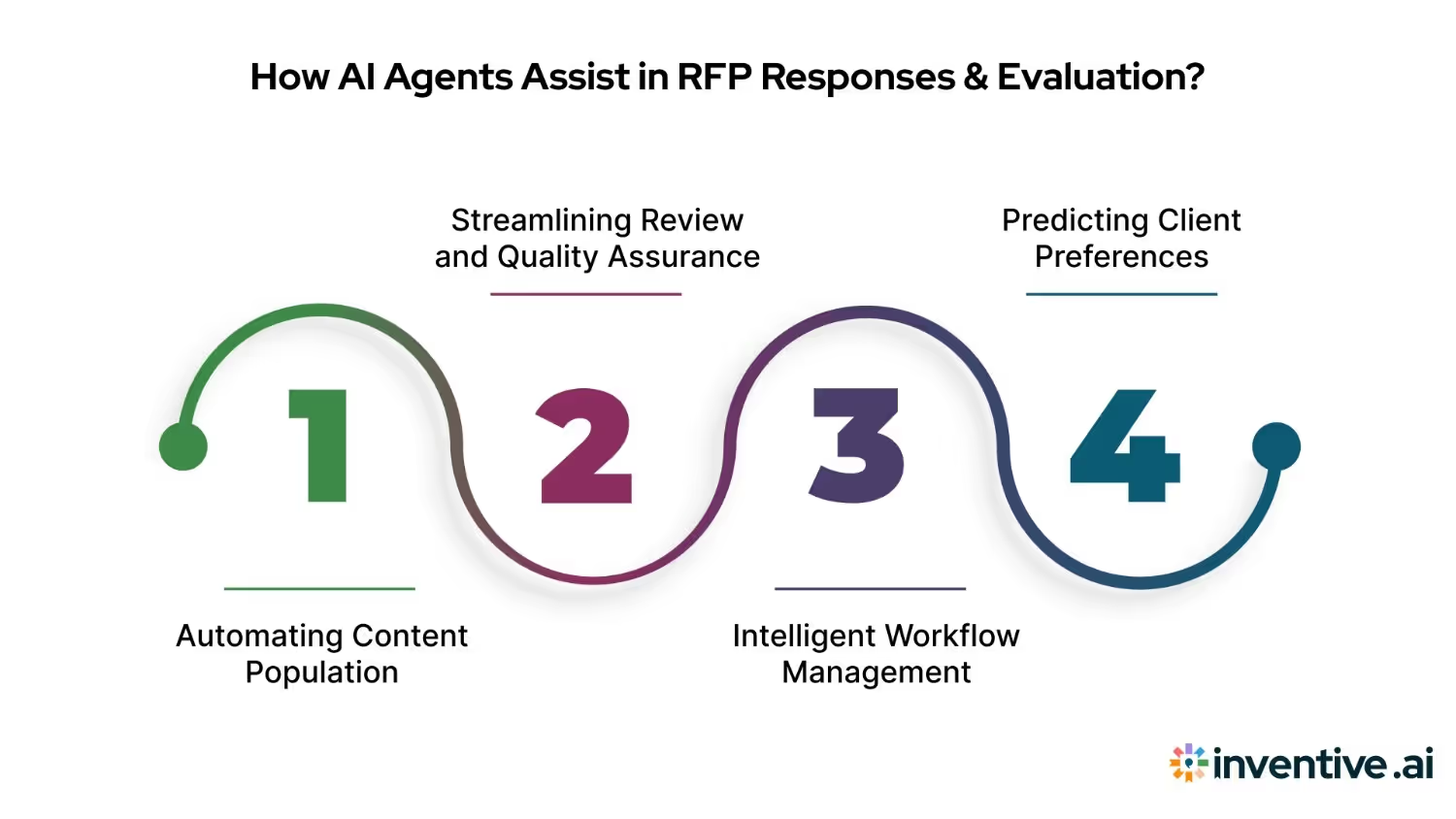
AI agents can be a game-changer in the RFP response process, offering both automation and intelligence that accelerate workflows and improve accuracy. Research shows that teams using RFP software average 179 RFP responses annually, in contrast to teams without such software, who manage only 145 responses.
- Automating Content Population: AI can now dynamically generate context-aware responses based on historical data and client needs, going beyond simple templates. It automatically inserts relevant technical details, pricing models, and compliance references, reducing manual work and speeding up content creation without sacrificing relevance.
- Streamlining Review and Quality Assurance: AI helps identify inconsistencies and errors in real time, ensuring the proposal aligns with client expectations. It automates the review process, allowing teams to focus on high-value tasks, improving overall quality and accuracy.
- Intelligent Workflow Management: AI optimizes task assignments, tracks progress, and sends automatic reminders. It adjusts timelines based on project needs, ensuring that all tasks are completed on time, streamlining the RFP process.
- Predicting Client Preferences: AI analyzes past RFPs and client feedback to predict what aspects of your proposal will resonate most. This helps tailor responses to meet client expectations, boosting the chances of winning the deal.
Read more: AI-Enhanced RFP Proposal Guide for Small Businesses.
With AI agents helping your team, it's essential to understand why choosing Inventive AI will optimize your RFP responses and set your team up for success.
Why Choose Inventive AI for a Comprehensive RFP Response Process?
Inventive AI enhances the RFP process by streamlining tasks, boosting accuracy, and making proposals more competitive. With features designed to improve efficiency, it optimizes everything from content generation to team collaboration.
- AI-Powered Responses with Citations and Confidence Scores: Inventive AI generates responses using internal knowledge, ensuring accuracy with citations and confidence scores. This reduces the risk of errors, offering transparency and reliability, which builds trust with clients and simplifies the process.
- Highly Contextual Responses with AI Context Engine: The AI Context Engine pulls data from sources like RFPs, customer info, and meeting notes to craft responses that are relevant and tailored. This ensures your proposal directly addresses client needs, improving your chances of success.
- Full Tone & Style Control: Inventive AI lets your team control tone, length, and detail, tailoring responses for different audiences. This flexibility helps quickly create proposals that align with client expectations and project goals.
- Knowledge Hub from Internal Systems: Inventive AI centralizes content from tools like Google Drive, SharePoint, and Notion, providing easy access to updated information. It also flags outdated content, ensuring consistency across proposals and streamlining the process.
- AI Agents for Competitive Advantage: The competitor research agent analyzes competitor data to uncover key differentiators, while the brainstorming agent helps develop win themes and value messaging. These insights make your proposals more competitive and client-focused.
- Collaboration Built for Cross-Functional Teams: Inventive AI improves collaboration by allowing teams to assign tasks, track progress, and leave feedback in real time. Integrations with tools like Slack ensure teams stay aligned, reducing delays and improving efficiency.
- Instant Checklist Creation for Winning Proposals: Using Inventive AI, you can instantly create a checklist for all tasks required to enhance your chances of winning the RFP. After responding, you can also track whether the checklist has been completed, ensuring nothing is overlooked and every step is covered for a successful submission.
FAQs
What is an RFP checklist, and why is it important?
An RFP checklist ensures that all steps in the RFP response process are covered efficiently, reducing errors and ensuring quality in the final proposal.
How can I improve my RFP response process?
By using a structured RFP checklist, assigning clear roles, setting timelines, and leveraging AI to automate repetitive tasks, you can significantly enhance your response quality and efficiency.
What are the key components of an effective RFP checklist?
The key components include understanding the client’s needs, assigning roles and responsibilities, setting realistic timelines, streamlining communication, and implementing a quality assurance process.
How does AI help in the RFP response process?
AI automates content creation, helps streamline reviews, manages workflows, and predicts client preferences, ensuring faster, more accurate responses.
What industries benefit from a customized RFP checklist?
All industries benefit, but sectors like healthcare, technology, manufacturing, and government contracts have specific compliance and technical needs that make a customized checklist essential.

90% Faster RFPs. 50% More Wins. Watch a 2-Minute Demo.
Mukund Kumar is a Growth Marketing Manager at Inventive AI, an IIT Jodhpur graduate with 3+ years of experience in growth marketing focused on user acquisition, performance campaigns, and data-driven strategies to scale AI-powered B2B solutions.
Dhiren Bhatia is the Co-founder and CEO of Inventive AI, where he is leveraging Generative AI to help sales teams respond to RFPs 10x faster. Before Inventive, Dhiren founded Viewics, a successful healthcare analytics platform that was acquired by Roche in 2017. With a background in building scalable enterprise software, he brings deep expertise in product strategy and AI-driven automation.

.jpeg)
